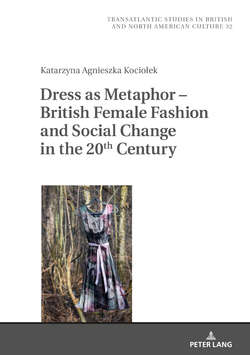Dress as Metaphor British Female Fashion and Social Change in the 20th Century

Реклама. ООО «ЛитРес», ИНН: 7719571260.
Оглавление
Katarzyna Kociolek. Dress as Metaphor British Female Fashion and Social Change in the 20th Century
About the author
About the book
This eBook can be cited
ACKNOWLEDGEMENTS
CONTENTS
INTRODUCTION
1 THEORIES OF FASHION. 1.1 Fashion as Communication
1.2 Identity Formation Through Fashion: Gender, Class, Subculture, Age
2 THE METAPHORS WE LIVE IN – DRESS AS A METAPHOR. 2.1 Conceptual Metaphor Theory and Fashion
2.2 Seeing Through Clothes – Fashion as Metaphor in Visual Culture
3 SARTORIAL PRACTICES AND METAPHORS IN THE REPRESENTATIONS OF THE BRITISH SUFFRAGETTES AND THE FLAPPERS. 3.1 Fashionable Suffragettes
3.2 The Flappers and Their (Mis)representation in the British Media
4 THE UNIFORMED FEMINITY OF THE WARTIME FASHIONS. 4.1 Civilians in Uniforms – Sartorial Representations of Female Identity During the WWI
4.2 Utility Fashion and Military Women of WWII
5 THE POST-WAR SUBCULTURAL REBELLION AND WOMEN’S FASHION OF THE TEDDY GIRLS, MODS AND PUNKS. 5.1 The Teds
5.2 The Mods
5.3 The Punks
6 ANTI-FASHION OF THE SECOND WAVE FEMINISM. 6.1 British Second-Wave Feminism, Spare Rib, and Fashion
6.2 Feminist Fashion in Anti-feminist Cartoons
7 POLITICAL LEADERSHIP AND FEMALE FASHION IN THE 1990s. 7.1 British Political Institutions and Their Dress Codes as Metaphors
7.2 British Women in Politics: Betty Boothroyd’s Style as a Metaphor of Tradition
CONCLUSION
Works Cited
Index
Отрывок из книги
Katarzyna Agnieszka Kociołek
Dress as Metaphor – British
.....
Despite such overtly negative connotations, the popularity of stilettos continued and they became particularly appealing to the young generation of consumers who sought to sartorially separate themselves from their mothers. According to Wright, thanks to the fact that “the stiletto did not symbolise the housewife” (Wright 203), from the late 1950s onwards it “was associated with glamour, with rebellion; it represented someone who was in some way ‘modern’ and ‘up to date’, and, above all, someone who inhabited a world outside the home” (203). Such connotations allow to view stilettos as liberatory rather than repressive, observes Wright, adding that stilettoes are too hastily blamed for women’s subordination in the 1950s. While the fashion of the decade accentuated gender differences more than the styles that followed, Wright suggests that this might have been a better strategy to empower femininity than its alternative, that is the downplaying of gender differences and the adoption of male styles. In Western cultures stilettos are chiefly associated with mature femininity, but the variety of designs results in a number of conflicting meanings assigned to them.
The discourse of women’s empowerment through fashion is deeply ingrained in the “ ‘power dressing phenomenon” (Entwistle 2007, 208) that appeared in the 1980s. Unlike Wright, Joanne Entwistle, who examines the issue, argues that borrowings from the male sartorial practices allowed to construct new modes of femininity. Through their power suits, the new professionally successful women connoted independence and ambitious career prospects as well as manifested changes in the social position of women. In order to examine the meanings of power dressing, Entwistle traces the developments in female sartorial practices in the context of women’s access to paid labour. She observes that while already in the 19th century women could secure positions as clerks and secretaries, the clothes they wore to work signified their separation from the higher ranks of business hierarchy, and indicated their exclusion from the top managerial jobs. It was not until the 1970s and the 1980s that suited women gained public visibility and numerous conduct manuals offered advice on how to dress for executive, as opposed to secretarial, jobs. Although, as noted by Entwistle, dress manuals had long pre-dated the phenomenon of power dressing, the “rules of ←31 | 32→‘dress for success’ ” (2007, 210) constructed entirely novel way of being a woman. Addressing women who made inroads into traditionally male occupations, these manuals stressed the importance of “the management of appearance” (211) and offered advice on how to achieve “something previously the preserve of men, career success” (211).
.....